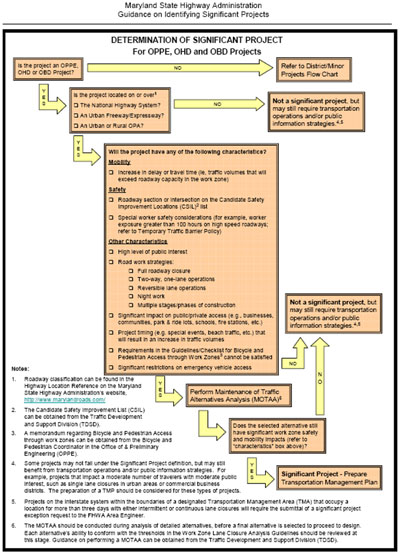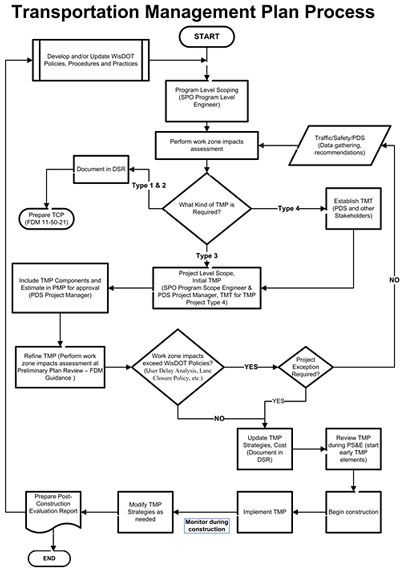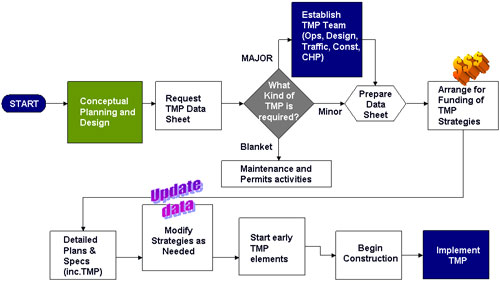VI. Course Material - Module 2: TMP Basics
slide 1
Module 2: TMP Basics


narrator notes
This module discusses the basics of a Transportation Management Plan (TMP)—the what, why, when, and who of TMP development. Examples from various States are used to illustrate a particular concept, but are not the only way the concepts can be implemented.
slide 2
About Module 2
- What is a TMP?
- Why a TMP is Needed?
- TMP Benefits
- TMPs and Significant Projects
- State Examples of Significant Project Criteria
- When to Develop a TMP
- Who Develops, Approves, and Implements a TMP
- TMP Process
- TMP Format
- TMP Implementation Costs
narrator notes
Module 2 starts with a general description of a TMP and explains why a TMP is needed and what benefits it provides. The module then covers how TMP requirements are affected if a project is significant or not and provides some examples of significant project criteria. The module also covers when to develop the TMP, who is involved, and possible processes and formats. The module concludes with a brief discussion on TMP costs.
slide 3
What is a TMP?
- Design documents show how a project will be built
- The TMP shows how the traffic will be managed during construction
- TMP is required for all Federal-aid projects
- Scalable to the projects
narrator notes
A DOT develops design documents often called "blue prints" for construction. A TMP can be viewed as the "blue print" for managing transportation needs during construction. A TMP is required for all Federal-aid projects.
Just as the design blue prints are more involved for a complex project, the TMP should be more involved for projects with greater transportation needs.
slide 4
A TMP is Also…
- A living document with:
- A set of coordinated transportation management strategies
- Description on how these strategies will be used to manage work zone impacts
- Updated as:
- Project progresses from scoping towards construction
- Major work zone changes occur during construction
narrator notes
A TMP lays out a set of coordinated transportation management strategies in order to improve safety and mobility in and around a work zone.
TMP development begins in the early planning stages of the project. The TMP is then updated as the project goes through different stages of planning and design. Once the TMP is implemented during construction, it needs to be monitored. If any major work zone adjustments are needed, the TMP must be revised to reflect the changes. That is why a TMP is also referred to as a "living document".
slide 5
Why a TMP is Needed?
- Work zone management is increasingly complex:
- Increasing traffic volumes use the same roads that Agencies must maintain and rehabilitate
- Requires traffic management efforts beyond Temporary Traffic Control (TTC) Plans
- TMP = more comprehensive approach to manage work zone impacts:
- Safety
- Mobility
narrator notes
The TMP provides a holistic way of looking at all the traffic-related impacts from the project and determining what strategies need to be in place to minimize the impacts.
Many urban areas have increasing congestion. In many areas the morning and afternoon peak period lasts several hours, and there may be a mid-day peak. This makes it increasingly challenging for work zone traffic management because a growing portion of road work is maintenance, reconstruction, and improvements to existing roads. These roads already carry traffic and are an important part of the transportation system, so closing lanes and staging construction is challenging.
The TMP provides a strategic approach to estimate traffic impacts for upcoming work zones and plan for and/or mitigate their effects.
slide 6
TMP Benefits
- Address work zone safety and mobility impacts from a broader transportation management perspective
- Promote more efficient and effective construction staging, duration, and costs:
- Minimize traffic mobility impacts
- Improve public awareness-minimize complaints
- Minimize impacts to local communities and businesses
- Improve intra and interagency coordination
- Improve coordination with surrounding concurrent projects
narrator notes
The updated Rule brings a more complete approach to addressing work zone impacts, often resulting in:
- Improved safety,
- Reduced traffic delay/travel time,
- Reduced lane closure hours,
- More satisfied road users, and
- Reduced Agency cost.
The most significant TMP benefits relate to the safety and mobility of the road user and workers. Other key benefits include the efficient sharing of project information with related stakeholders as well as the intra- and inter-agency coordination developed.
Even if good planning and TMP development is done for a project, unexpected issues can result if traffic diverts to the area as a result of another project nearby. So it is important to consider the impacts of other concurrent construction projects in the area. The TMP process can help foster this coordination by bringing stakeholders together.
slide 7
TMPs and Significant Projects
- Rule definition:
- Projects that, alone or in combination with other concurrent projects nearby, cause sustained work zone impacts that are:
- Greater than tolerable
- Based on DOT Policy or engineering judgment
- All Interstate system projects:
- Within a Transportation Management Area (TMA)
- Occupy a location for more than 3 days
- With intermittent or continuous lane closures
- Projects that, alone or in combination with other concurrent projects nearby, cause sustained work zone impacts that are:
narrator notes
We have mentioned the term "Significant Project", but what does that mean? FHWA defines a significant project as one that has the potential to cause sustained work zone impacts that are greater than what is considered tolerable – based on Agency policy or engineering judgment. A project can be significant because it causes these impacts on its own, or in combination with other projects that will occur nearby at the same time.
At a minimum, all Interstate system projects within the boundaries of a designated Transportation Management Area that occupy a location for more than 3 days and have some type of lane closures are to be considered significant projects.
In summary, a significant project is one that is expected to cause a relatively high level of impacts or disruption.
slide 8
TMPs and Significant Projects
- TMPs for Significant Projects must include:
- Temporary Traffic Control Plan (TTCP)
- Transportation Operations (TO) strategies
- Public Information & Outreach (PI) strategies
- All 3 components above required for significant projects; level of detail in each section depends on expected impacts and scalability of the projects
- For other projects:
- TTCP required
- TO as appropriate
- PI as appropriate
narrator notes
Some road projects lead to more transportation issues than other projects. So the effort to plan for and manage those impacts should be scalable to the project. The scope, content, and level of detail of a TMP will vary based on the project cost and size, the anticipated work zone impacts of the project, as well as the Agency's work zone policy. A project expected to cause more disruption will require a more extensive TMP. The purpose of identifying significant projects is to "flag" higher-impact projects early on so that greater effort is spent on those projects that most need it.
The required components of a TMP depend on whether a project is a significant project. A TMP must always include a Temporary Traffic Control Plan. For significant projects, TMPs must also contain Transportation Operations and Public Information components.
As mentioned, Agencies have some flexibility to determine what impacts are tolerable in their jurisdiction. The following slides are Agency examples of significant project definition. The examples illustrate that States have developed project criteria which varies from relatively simple to quite complex.
Some additional information is available in the Participant Workbook
For more information Refer to the FHWA Guide titled, Implementing the Rule on Work Zone Safety and Mobility available at http://www.ops.fhwa.dot.gov/wz/resources/final_rule/guidance.htm.
slide 9
State Examples of Significant Project Criteria
Maryland
- Qualitative approach to define significant projects
- Engineering judgment plays role
- Two key processes:
- Looks at WZ impacts on more complex projects:
- Location
- Mobility Impacts
- Safety Impacts
- Work Zone Characteristics
- Looks at District and minor projects:
- Freeway/Expressway lane closures for more than 3 days
- Increase in queue/delay greater that exceeds allowable mobility thresholds
narrator notes
Maryland uses two processes to determine its significant projects.
Process one is for projects that fall under the Planning and Design Central Offices, which tend to be larger, more complex projects. The major criteria used are project location, anticipated mobility and safety impacts, and project and/or work zone characteristics. Once deemed significant, the next step is to perform a Maintenance of Traffic Alternative Analysis. If the analysis does not identify a solution that will reduce impacts, traffic operations and public information and outreach strategies must be developed.
Process two is at the District level and relates to minor projects where the work will involve continuous or intermittent lane closures on a freeway/expressway for more than 3 days.
slide 10
State Examples of Significant Project Criteria
Maryland
Example of one of Maryland's Flowcharts for Determining Significant Projects
narrator notes
Maryland has developed a flow chart for each of its two processes to help its engineers identify significant projects. This is the flow chart Maryland uses for more complex projects.
You can also refer to Appendix B of the Participant Workbook for a copy of this flowchart and the minor projects flowchart.
slide 11
State Examples of Significant Project Criteria
Michigan
- Significant Project, if any of the following criteria exist:
- Work zone delay greater than 10 minutes
- Work zone level of service (LOS) is lower than or equal to LOS D, or it drops to LOS C if the current operation is LOS A
- Work zone volume/capacity ratio is greater than 0.80
narrator notes
The Michigan Department of Transportation uses three thresholds to determine whether a project is significant. The thresholds are based on delay, level of service, and the ratio of volume to capacity. If one or more of these thresholds are exceeded, then the project is considered significant. For example, if a work zone is expected to cause additional delay of 15 minutes, beyond any pre-existing delay, the project is considered as a significant project in Michigan.
Like a number of other States, Michigan uses a computer program to analyze delay.
slide 12
State Examples of Significant Project Criteria
Tennessee
- Significant Project determination based on four criteria:
- FHWA definition
- When all lanes in one direction will be closed on any Interstate, or other road with AADT of at least 50,000 vehicles
- Work zone delay of at least 30 minutes
- Extraordinary qualitative characteristics
narrator notes
Tennessee uses four criteria to determine if a project is significant. The criteria include the FHWA definition mentioned earlier for Interstate projects, lane closures on major routes, expected extra delay due to the work zone, and extraordinary qualitative characteristics. Examples of these qualitative characteristics include high levels of public interest, business/community impacts, or long work zone duration. Meeting any one of these criteria can result in a project being designated as significant.
Refer to Appendix B of the Participant Workbook for a sample of the Tennessee flow chart on significant project determination.
slide 13
State Examples of Significant Project Criteria
Indiana
- FHWA Definition
- Other characteristics considered:
- Major reconstruction or new construction
- High traffic
- Urban areas
- Significant detrimental effects on mobility
- Ramp closures of 7 days or more
- Reasonable adjacent alternate is not available
- Significant impacts on local communities and businesses
- Timing and seasonal impacts may be significant
narrator notes
In Indiana, a project is considered significant if it meets the FHWA definition mentioned earlier, or if it meets both characteristics 1 and 2 shown on this slide. The project may also be considered significant if it meets either characteristic 1 or 2 and has one or more of the other six characteristics such as being in an urban area or having seasonal impacts.
slide 14
TMPs and Significant Projects
- Why it is important to identify significant projects?
- Potential to create greater impacts
- Warrant additional:
- Attention during project development and delivery
- Funding for transportation management
- When should we identify significant projects?
- As early as possible when the most options are available
This will help Agencies to:
- Allocate resources more effectively to projects likely to have greater impacts
- Think through project coordination and scheduling issues
narrator notes
Identifying significant projects during the early planning stages is critical as they have the potential to cause greater work zone impacts and may also need additional coordination, scheduling, and resources during project planning, design, and implementation. Beginning such efforts early in project development will help the DOT allocate the necessary resources to reduce and manage impacts to the traveling public, community, and businesses, and will allow for better coordination with other projects occurring in the area at the same time.
slide 15
When to Develop a TMP
- Begin TMP development during planning and progress through stages of the project:
- Planning/Scoping
- Design
- Construction/Implementation
- Design-build projects – Initial TMP may include series of procedures for the Contractor to follow
A TMP is a living document to be revised periodically as major changes are made. Update the TMP, as needed, throughout project development and implementation.
narrator notes
TMP development begins during project conceptualization or the early planning stages of a project. At this stage of the project, more alternatives and strategies are available for addressing the anticipated work zone impacts. Some feasible alternatives may cause much greater traffic impacts than other alternatives. As the alternatives are being analyzed, work zone impacts should be considered as a factor in the decision-making.
As the project progresses through the different stages of design, the TMP evolves. The strategies selected are reassessed to confirm that work zone impacts are addressed and the TMP is updated as needed. During construction, the TMP is implemented, and if any major work zone adjustments are needed, the TMP is revised to reflect the changes.
In Design/Build projects the construction proceeds along with the design and TMP development. The initial TMP may include a series of procedures that the Contractor must follow, such as for detours, lane closure hours, MOT inspection, and public information. The Contractor would fill in the TMP details as the project design progresses.
The TMP is a living document that needs to be updated regularly through out the life of the project.
slide 16
Who Develops, Approves and Implements a TMP
- Development—State/Local Agency or Consultant and/or Contractor
- Approval—State/Local Agency
- Implementation—Contractor and State/Local Agency
- Monitoring—State/Local Agency and Contractor
narrator notes
DOTs or their design consultants generally develop the TMP, while the implementation and monitoring is a joint effort between the Contractor and the DOT. The State or local transportation Agency must approve the TMP before it's implemented. However, in some practices like design-build, the Contractor develops the TMP and once approved by the DOT, the Contractor will be responsible for its implementation.
The following slides illustrate a few examples of TMP processes.
slide 17
TMP Process
Generic TMP Development Process—Example
narrator notes
The TMP steps during the three main stages of project delivery are shown in this example, which comes from the FHWA Guide Developing and Implementing Transportation Management Plans.
During planning and design the TMP needs are determined and the TMP is developed.
During construction, the TMP is implemented and monitored for impacts and revised as necessary. The TMP may be updated during this time for reasons such as Contractor requested changes to construction phasing or excessive queues at the work zone.
Once the project is completed, a post-project evaluation is conducted to assess TMP performance and lessons learned.
slide 18
TMP Process—Other State Examples
Wisconsin
narrator notes
This example illustrates the Wisconsin DOT Transportation Management Plan Process. Wisconsin DOT does a systematic assessment of work zone impacts for construction projects that affect travel lanes. They categorize TMPs into four different types, with types 3 and 4 being significant.
At the program level-scoping phase, a preliminary work zone impact assessment is conducted to determine the type of TMP. A preliminary TMP is prepared at this stage.
During the preliminary plan review stage, work zone impacts are re-assessed for type 3 and type 4 TMPs using formalized guidance called Lane Closure and Delay Guidelines. If the impacts are determined to be within Wisconsin DOT policies, TMP update and implementation continues. If the impacts are determined to exceed Wisconsin DOT policies and a project exception is not approved, the TMP strategies are revised and impacts are re-assessed. The goal is to mitigate to the greatest extent possible, safety and mobility impacts to workers and the public.
Some additional information is available in the Participant Workbook
For more information refer to Traffic Analysis Tools Volume IX: Work Zone Modeling and Simulation Guide for Analysts available at: http://ops.fhwa.dot.gov/wz/traffic_analysis/index.htm.
slide 19
TMP Process—Other State Examples
Caltrans
narrator notes
This example illustrates the Caltrans TMP Development process.
Caltrans considers the TMP from the conceptual planning and design stages. A TMP datasheet helps to define the project into minor, major, or blanket TMP categories. For all major TMPs, a TMP Team is created to ensure the involvement of key stakeholders in developing the TMP.
Some additional information is available in the Participant Workbook
Other Information:
From presentation by Traffic Management Branch, Division of Traffic Operations, CALTRANS on Transportation Management Plans - Managing Congestion in Work Zones available at: http://www.ntoctalks.com/webcast_archive/to_feb_17_05/to_feb_17_05jg.ppt#7.
slide 20
TMP Format
- TMPs need to be documented
- Format may vary:
- Single document with all materials
- Brief document with a summary of analyses and references to supporting information
- Templates
- Workbooks
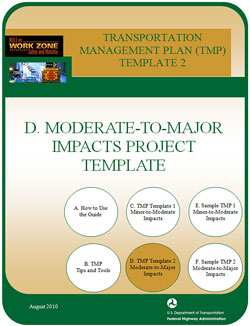
narrator notes
TMPs are a formal plan which can be an all-inclusive document or a summary document with supporting information provided in appendices or project files. The final document format depends on the DOT and its Policy guidelines.
Some States use TMP templates or workbooks to aid staff in developing TMPs. Other States use a typical report format.
slide 21
TMP Template—Rhode Island
- Ensure:
- Key steps are completed during TMP development
- TMPs do not overlook key items
- Can aid in TMP review, approval, and evaluation
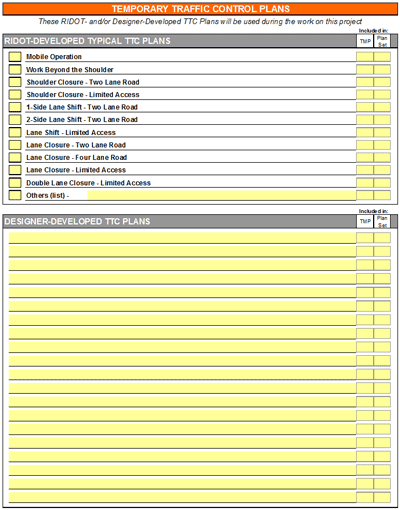
Extract from Rhode Island Templates
narrator notes
Rhode Island DOT has developed four TMP templates. The template used depends on the impact level of the project, with levels 1 and 2 designated as significant.
Its TMP templates help Rhode Island DOT ensure that key steps are completed during TMP development and that TMPs do not overlook key items. Its templates also help provide some consistency, which can aid in TMP review, approval, and evaluation.
While aiding in consistency, templates can also allow flexibility and vary based on the complexity and level of impacts anticipated for the project.
Some additional information is available in the Participant Workbook
More Information:
For more information on Rhode Island Templates visit: http://ops.fhwa.dot.gov/wz/resources/final_rule/tmp_examples/ridot_tmps.htm.
slide 22
TMP Template—Tennessee
- Serves as TMP decision-making platform
- Helps document TMP development.
- Two parts:
- Part 1—Significant project determination, completed by planning staff
- Part 2—TMP Strategies, completed by designers.
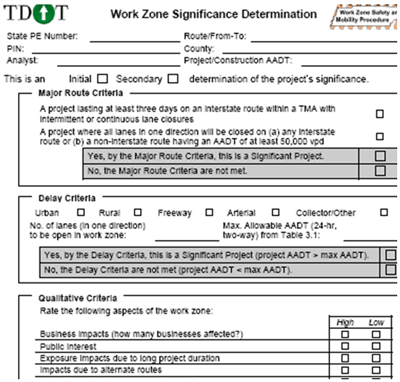
Extract from Tennessee Workbook
narrator notes
The Tennessee Department of Transportation developed a TMP Workbook to aid DOT staff in developing TMPs. The Workbook serves as a decision-making platform for the TMP and also helps document TMP development. The first part of the Workbook, Project Significance Determination, is completed by the planning staff, and then the Workbook is passed forward to designers who complete the sections on TMP strategies during project design.
Some additional information is available in the Participant Workbook
More Information:
For more information on Tennessee workbook visit: http://ops.fhwa.dot.gov/wz/resources/final_rule/tmp_examples/tmp_dev_resources.htm.
slide 23
Sample TMP Outline
- Project Description
- TMP Team—Roles and Responsibilities
- Preliminary Work Zone Analysis
- Existing Conditions
- Operational Analysis:
- Safety Analysis
- Traffic Analysis
- Work Zone Impact Management Strategies:
- Temporary Traffic Control
- Transportation Operations
- Public Information
- Incident Management/Contingency Plan
- Special Considerations/Notes
- TMP Implementation/Monitoring Requirements
- Review/Approvals
- Appendices
narrator notes
A typical TMP will contain many of these elements. However, it is important to keep in mind that some TMPs will be relatively simple, while others will be much more involved and detailed. The scope and level of detail depends on a number of factors including whether a project is significant; the potential work zone impacts of the project; and Agency policies, procedures, and guidelines.
In some States the TMP is a shared responsibility among many Departments. For example, the traffic analysis may be completed by the Safety Office while the traffic control plan may be done by the Traffic Office. This information needs to be conveyed to the TMP developers.
slide 24
TMP Implementation Costs
- TMP development process
- TMP strategies
- Monitoring
- Post project activities
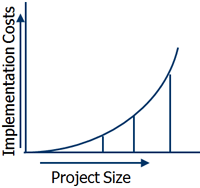
Estimate the work zone management strategy implementation costs of the TMP. Include these costs within the overall project cost.
This is crucial:
- As it may be difficult to obtain additional funding at a later time
- This potentially avoids under-allocation of funds
narrator notes
The TMP cost includes the TMP development process, the implementation of the selected strategies, monitoring during construction, and any post project activities. TMP cost will vary based on project size, the extent of project impacts, location, and duration of the project. Generally the larger and more complex a project is, the greater the overall TMP cost.
Estimating the costs to implement the TMP and including these costs within the overall project cost is critical, as it may be difficult to obtain additional funding at a later time.
When there is more than one project occurring in an area, it may be possible to share some TMP costs across projects, such as costs for a public outreach campaign or the use of a motorist assist patrol to address disabled vehicles.
slide 25
Paying for TMP Implementation
- Determine who is responsible for implementing each strategy
- Construction Contractor
- Include means of payment in contract
- Other Contractor
- Establish or modify other contract
- Agency
- Coordinate with relevant Agency departments
narrator notes
Cost estimates for the various TMP strategies should be itemized and documented when feasible, with cost responsibilities, opportunities for sharing or coordinating with other projects, and funding sources specified. TMP strategies can be funded as part of the construction contract, in separate agreements with other Contractors, and within the owner-agency. For example, if one of the TMP strategies is to implement a temporary intelligent transportation system for work zone monitoring and management, the Agency might include that strategy in the construction contract or might implement it through a separate agreement with a consultant or vendor. For public information strategies, an Agency might choose to use a separate consultant contract with a pubic relations firm or have the outreach strategies done by the Agency's own Pubic Information Officer.
Provisions for a TMP must be included in the project's Plans, Specifications, and Estimates, or PS&Es. The PS&Es must either contain all the elements of an Agency-developed TMP that will be implemented by the construction Contractor, or include provisions for the Contractor to develop and implement a TMP. Specific pay item provisions for the TMP also need to be included. Pay item provisions can be individual pay items, lump sum, or a combination of these methods, or as performance-based specifications that stipulate performance criteria and standards. TMP strategies should not be considered incidental to a contract.
slide 26
In Summary, TMPs…
- Are required for all Federal-aid projects
- Are a plan showing how the traffic will be managed during construction
- Address work zone safety and mobility impacts
- Should be started early in project development and updated throughout
- Need to approved, implemented, and monitored in the field
narrator notes
To review what we learned in this module:
- DOTs must create a TMP for every Federal-aid road project.
- TMPs are a formal plan that shows how traffic will be managed during construction.
- TMPs reduce and manage the safety and mobility impacts of work zones
- Developing an effective TMP is an effort that should be started early in project development, and then updated as the project progresses through preliminary engineering, design, and construction.
- A TMP must be approved by the DOT before implementation. After it is implemented in the field, it needs to be monitored to see if it is effectively managing traffic.
